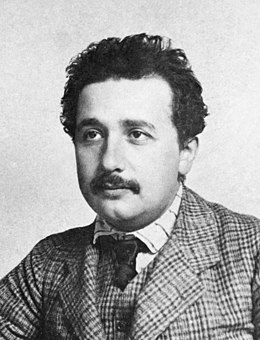9 jan. 2017
Learning Physics/ special relativity

Suppose a clock is at rest in the unprimed system S. The location of the clock on two different ticks is then characterized by Δx = 0. To find the relation between the times between these ticks as measured in both systems, the first equation can be used to find:
Similarly, suppose a measuring rod is at rest and aligned along the x-axis in the unprimed system S. In this system, the length of this rod is written as Δx. To measure the length of this rod in the system S′, in which the rod is moving, the distances x′ to the end points of the rod must be measured simultaneously in that system S′. In other words, the measurement is characterized by Δt′ = 0, which can be combined with the fourth equation to find the relation between the lengths Δx and Δx′:
postulates
Einstein discerned two fundamental propositions that seemed to be the most assured, regardless of the exact validity of the (then) known laws of either mechanics or electrodynamics.
These propositions were the constancy of the speed of light and the independence of physical laws (especially the constancy of the speed of light) from the choice of inertial system. In his initial presentation of special relativity in 1905 he expressed these postulates as:[1]
Learning Physics/ special relativity
Contents
- 1 Postulates
- 2 Lack of an absolute reference frame
- 3 Reference frames, coordinates, and the Lorentz transformation
- 4 Consequences derived from the Lorentz transformation
- 5 Other consequences
- 6 Causality and prohibition of motion faster than light
- 7 Geometry of spacetime
- 8 Physics in spacetime
- 9 Relativity and unifying electromagnetism
- 10 Status
- 11 Theories of relativity and quantum mechanics
- 12 See also
- 13 References
- 14 External links

Albert Einstein around 1905, the year his "Annus Mirabilis papers" – which included Zur Elektrodynamik bewegter Körper, the paper founding special relativity – were published.

In physics, special relativity (SR, also known as the special theory of relativity or STR) is the generally accepted and

Contents
Time dilation
See also: Time dilation
The time lapse between two events is not invariant from one observer
to another, but is dependent on the relative speeds of the observers'
reference frames (e.g., the twin paradox
which concerns a twin who flies off in a spaceship traveling near the
speed of light and returns to discover that his or her twin sibling has
aged much more).Suppose a clock is at rest in the unprimed system S. The location of the clock on two different ticks is then characterized by Δx = 0. To find the relation between the times between these ticks as measured in both systems, the first equation can be used to find:
for events satisfying
Length contraction
See also: Lorentz contraction
The dimensions (e.g., length) of an object as measured by one
observer may be smaller than the results of measurements of the same
object made by another observer (e.g., the ladder paradox involves a long ladder traveling near the speed of light and being contained within a smaller garage).Similarly, suppose a measuring rod is at rest and aligned along the x-axis in the unprimed system S. In this system, the length of this rod is written as Δx. To measure the length of this rod in the system S′, in which the rod is moving, the distances x′ to the end points of the rod must be measured simultaneously in that system S′. In other words, the measurement is characterized by Δt′ = 0, which can be combined with the fourth equation to find the relation between the lengths Δx and Δx′:
for events satisfying
postulates
Einstein discerned two fundamental propositions that seemed to be the most assured, regardless of the exact validity of the (then) known laws of either mechanics or electrodynamics.
These propositions were the constancy of the speed of light and the independence of physical laws (especially the constancy of the speed of light) from the choice of inertial system. In his initial presentation of special relativity in 1905 he expressed these postulates as:[1]
- The Principle of Relativity – The laws by which the states of physical systems undergo change are not affected, whether these changes of state be referred to the one or the other of two systems in uniform translatory motion relative to each other.[1]
- The Principle of Invariant Light Speed – "... light is always propagated in empty space with a definite velocity [speed] c which is independent of the state of motion of the emitting body" (from the preface).[1]
- That is, light in vacuum propagates with the speed c (a fixed constant, independent of direction) in at least one system of inertial coordinates (the "stationary system"), regardless of the state of motion of the light source.


No comments:
Post a Comment